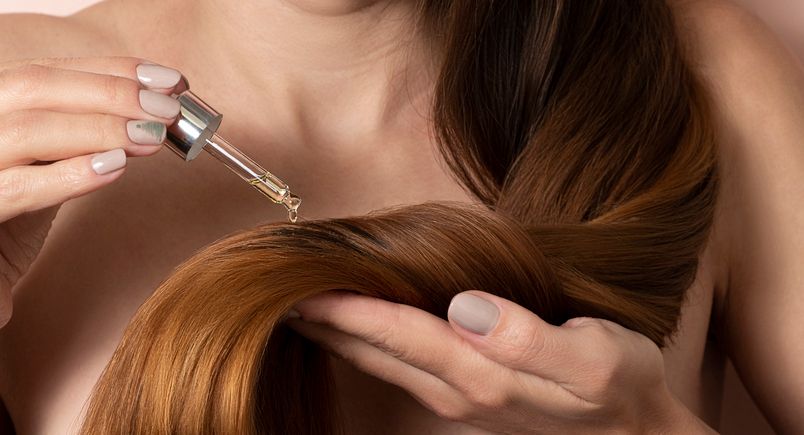
Author: Natalie Ng|Updated: 22 May 2025
You might notice small bald patches, short broken hairs, or sections where your hair looks thinner. Patchy hair loss appears in different ways depending on the cause. Some people see clear bald spots on the scalp or body. Others experience overall hair thinning or sudden shedding. These changes often reflect a shift in how your hair follicles function or how your immune system is reacting. Alopecia areata is a common reason behind patchy areas. It happens when immune cells attack the follicles, leading to smooth bald spots. Hormonal changes linked to conditions like androgenetic alopecia, thyroid disease, or female pattern baldness also affect the normal hair cycle. Scalp diseases such as fungal infections, local inflammation, or other chronic conditions can cause hair to fall out. Some people lose hair due to emotional stress, certain medications, or nutrient deficiencies that affect iron or vitamin D levels. Hair typically falls when follicles are damaged or inactive. In some cases, hair regrows. In others, bald patches may spread or become more noticeable. Whether it’s related to severe alopecia areata, telogen effluvium, or slow regrowth, different causes lead to different outcomes. The sections below break down the most common causes of patchy hair and explain the treatments that can help restore balance.

Alopecia Areata and Hair Follicle Damage

Alopecia areata is an autoimmune disease where immune cells attack healthy hair follicles. This causes sudden, round bald patches to form, most often on the scalp. In more severe cases, it can also affect eyebrows, eyelashes, or body hair.
Hair typically falls out quickly in small, smooth circles. Short broken hairs may appear at the edges of these patches. In some cases, shedding stops and regrowth begins. In others, the hair loss continues or spreads to other parts of the scalp and body.
There are different forms of this condition:
• Patchy alopecia areata causes scattered bald spots
• Diffuse alopecia areata leads to widespread thinning without clear patches
• Alopecia areata totalis results in complete loss of scalp hair
• Alopecia areata universalis includes total body hair loss
Severe alopecia areata can significantly impact quality of life, and treatment options such as corticosteroids and recently approved FDA medications like JAK inhibitors are available for adults suffering from this condition.
People with a family history of autoimmune conditions, or those with thyroid disease or connective tissue disease, may be at higher risk. Emotional stress, scalp infections, or chronic illness may trigger or worsen symptoms.
Diagnosis is based on clinical signs, but scalp biopsy or blood tests may be used to rule out other causes. Early detection helps manage further hair loss and improves the chance of hair regrowth.

Pattern Hair Loss and Inherited Causes
Pattern hair loss, also called androgenetic alopecia, is the most common cause of gradual thinning in both men and women. It is linked to a genetic sensitivity to dihydrotestosterone (DHT), a hormone that gradually shrinks hair follicles over time.
In men, the condition usually begins at the temples or crown. Hair follicles in these areas react to DHT by producing thinner strands. Over time, they stop growing hair altogether, leading to bald spots or a receding hairline.
In women, the pattern is different. Hair thins across the top of the scalp, but the hairline often remains unaffected. This is referred to as female pattern baldness. Unlike patchy forms of hair loss, pattern thinning develops slowly and follows a consistent shape.
This condition tends to run in families. Both sides of the family may carry the genetic traits that affect how your hair follicles respond to hormonal changes. Although the hair typically falls in stages, the process is progressive and permanent without treatment.
Book Now to Experience
F8 Hair Regrowth Treatment
1 Minute Self-Registration
Date should not be before minimal date

Hair Loss from Thyroid and Hormonal Changes
Hormonal shifts often affect the normal hair cycle, especially when related to thyroid dysfunction. Both overactive and underactive thyroid conditions can lead to noticeable hair changes, including diffuse thinning or patchy loss.
In hypothyroidism, hair becomes dry, brittle, and sheds more than usual. Thinning usually spreads across the scalp as follicle activity slows down. In hyperthyroidism, hair may feel fine and oily, with increased shedding in specific areas.
Another cause is Hashimoto’s disease, an autoimmune thyroid condition. It can lead to ongoing, diffuse hair thinning if untreated. These changes often reflect an imbalance in hormone levels that disrupt the growth phase of the hair cycle.
Women also experience hair changes linked to pregnancy and childbirth. During pregnancy, higher hormone levels may prolong the growth phase. After delivery, hormone levels drop, leading to temporary shedding known as postpartum telogen effluvium. This often peaks a few months after childbirth and is most visible around the hairline and crown.
These types of hair loss are usually reversible with proper diagnosis and hormone regulation. Blood tests confirm hormone levels, and recovery typically begins within a few months once balance is restored.

Nutrient Deficiencies That Weaken Hair Growth
Hair follicles rely on a steady supply of nutrients to stay active. When certain vitamins and minerals drop below optimal levels, the normal hair cycle slows down. Over time, this can cause hair to thin, fall out, or stop growing altogether. Additionally, thyroid and hormonal changes can lead to a significant loss of hair, affecting the overall health and appearance of your scalp.
Iron deficiency is one of the most common causes of diffuse hair shedding. Low iron reduces oxygen delivery to the scalp, which weakens the follicles. This type of hair loss often appears gradually and may be overlooked at first.
Vitamin D also plays a role. It helps regulate immune responses and supports follicle cycling. A lack of vitamin D is linked to autoimmune diseases like alopecia areata, where bald patches appear across the scalp or body.
Other key nutrients include:
• Protein, which supplies the building blocks for keratin
• Zinc, which helps repair tissue and reduce scalp inflammation
• Biotin, which supports strand strength and root health
Deficiencies may develop due to restrictive diets, poor absorption, or underlying medical conditions. Hair microscopy or blood tests can help detect the problem. Addressing these gaps early can restore proper function and help hair regrow over time.

Hair Loss Triggered by Stress
Emotional or physical stress can push a large number of hair follicles into a resting phase. This leads to a condition called telogen effluvium, where hair typically falls out about three to four months after the stressful event.
Hair shedding often affects the entire scalp instead of forming clear bald patches. You may notice more hair on your pillow, in the shower, or when brushing. Unlike autoimmune or genetic causes, this form of hair loss happens suddenly and may improve once the stressor is resolved.
Common triggers include:
• Surgery or serious illness
• Major life changes such as job loss or grief
• Ongoing anxiety or sleep disruption
• Nutritional changes or crash dieting
Telogen effluvium is usually temporary. Once stress levels stabilise, the normal hair cycle begins again. Hair regrows slowly, often taking several months to return to its previous density.
Book Now to Experience
F8 Hair Regrowth Treatment
1 Minute Self-Registration
Date should not be before minimal date

Scalp Infections and Local Inflammatory Conditions
Scalp infections and inflammatory disorders can interfere with hair follicle activity, leading to patchy hair loss, scalp irritation, and broken hair shafts. In many cases, these conditions directly affect the skin surface and need medical treatment to prevent further damage.
Fungal infections, like tinea capitis, are among the most common causes. They produce round bald patches, scaling, redness, and sometimes pus-filled bumps. Hair in the infected area often breaks off at the scalp, leaving black dots. This condition spreads easily, especially in children or shared environments.
Other conditions include:
• Folliculitis
Bacterial infection of the follicles that causes small red bumps and localized shedding.
• Seborrheic dermatitis
Inflammatory skin disorder that produces greasy flakes and mild hair thinning.
• Scalp psoriasis
Autoimmune skin disease that creates thick, scaly plaques and may lead to temporary hair loss due to scratching or inflammation.
• Piedra
Fungal condition that causes hard nodules along hair shafts, often requiring prescription treatment.
If scalp inflammation or infection is suspected, early diagnosis is essential. Treatments usually include antifungal or antibacterial medications, and in some cases, topical agents to calm inflammation. Once the infection clears, the follicles often resume normal growth.

Autoimmune and Chronic Illness-Linked Hair Loss
Certain chronic illnesses and autoimmune diseases can cause the immune system to target healthy hair follicles. This often leads to patchy or widespread shedding that progresses without warning. In some cases, the hair loss is linked directly to the condition itself. In others, it’s a side effect of the body’s overall immune response.
Alopecia areata, which causes distinct bald patches, is one of the most well-known autoimmune forms. But other conditions can also disrupt the hair cycle, including:
• Lupus and connective tissue diseases
Inflammatory disorders that may lead to diffuse hair thinning or focal hair loss on the scalp.
• Thyroid disease
Both underactive and overactive thyroid conditions interfere with hair regrowth, often resulting in brittle, thinning strands.
• Inflammatory bowel disease, rheumatoid arthritis, and other systemic autoimmune disorders
These may contribute to hair shedding indirectly through immune stress, medication effects, or poor nutrient absorption.
In these cases, the immune system causes ongoing inflammation around the follicles or alters hormone levels in ways that affect the scalp. Blood tests and a scalp biopsy may be used to identify the cause.
Once the underlying condition is treated or managed, hair may slowly return to its normal cycle. But in chronic cases, thinning may persist or become permanent without intervention.
Treatments That Support Hair Regrowth and Slow Hair Loss

Corticosteroids for Immune-Driven Hair Loss

Corticosteroids are commonly used to treat autoimmune-related hair loss, especially alopecia areata. This condition is characterized by the immune system targeting and damaging its own hair follicles, leading to patchy hair loss. These medications help reduce inflammation around the follicles by calming the overactive immune response.
There are different ways corticosteroids are used:
• InjectionsDirectly injected into bald patches on the scalp. This method is often used for small, clearly defined areas. Hair regrowth may begin within a few weeks of treatment.
• Topical creams or lotionsApplied to the affected area to reduce scalp inflammation. These are usually less effective than injections but can be helpful for children or people who cannot tolerate needles.
• Oral corticosteroidsUsed in more severe or widespread cases. These are taken for short periods due to the risk of side effects with long-term use.
These treatments work best when hair loss is recent. A dermatologist will typically assess the severity of shedding and decide on the method based on the size and location of bald patches.
Book Now to Experience
F8 Hair Regrowth Treatment
1 Minute Self-Registration
Date should not be before minimal date

Minoxidil for Stimulating Hair Growth
Minoxidil is a topical treatment used to boost hair regrowth and slow down thinning. It works by increasing blood flow to the scalp and improving oxygen delivery to the hair follicles. This helps extend the growth phase of the normal hair cycle.
Minoxidil is available in both liquid and foam forms. It is applied directly to the scalp once or twice a day, depending on the product strength. The treatment is commonly used for:
• Androgenetic alopecia
Helps slow down hair thinning and promotes regrowth in areas like the crown and hairline.
• Female pattern baldness
Supports overall density and reduces hair loss across the top of the scalp.
• Telogen effluvium and stress-related shedding
May help speed up recovery by reactivating dormant follicles.
Visible changes usually begin within three to six months of consistent use. Some people may experience temporary increased shedding during the early weeks, which is part of the follicle turnover process.
Minoxidil needs to be used regularly. If stopped, hair growth typically returns to its previous state. It is widely available without a prescription but works best under medical guidance.

Finasteride for Blocking DHT
Finasteride is an oral medication used to treat androgenetic alopecia by reducing levels of dihydrotestosterone (DHT), the hormone responsible for shrinking hair follicles in pattern hair loss.
The medication works by inhibiting the enzyme 5-alpha reductase, which converts testosterone into DHT. Lower DHT levels help protect hair follicles, slow down further hair loss, and support regrowth in thinning areas.
Finasteride is typically prescribed for men and is taken once daily in tablet form. Results often begin to appear within three to six months of continuous use. It is most effective when started in the early stages of hair thinning, particularly at the crown or temples.
This treatment is not usually recommended for women, especially during pregnancy, due to potential risks. For those who are eligible, regular use helps maintain existing hair and reduce the size of bald spots.
Stopping treatment may reverse progress, so ongoing use is often required for long-term results. Doctors may also combine finasteride with other therapies, such as minoxidil or low-level laser therapy, for stronger outcomes.

Hair Transplant Surgery

Hair transplant surgery is a long-term solution for people with advanced pattern hair loss or patchy areas that no longer respond to medical treatments. This procedure involves moving healthy hair follicles from one part of the scalp to another where hair is thinning or missing.
There are two main techniques:
• Follicular Unit Extraction (FUE)
Individual hair follicles are removed from the donor area, usually the back of the scalp, and placed into the thinning or bald areas. This method leaves tiny scars that are barely visible.
• Follicular Unit Transplantation (FUT)
A strip of scalp containing hair follicles is taken from the donor area, divided into grafts, and implanted into the target site. This approach may be more suitable for larger sections of hair loss.
Hair typically begins to regrow in the transplanted areas after three to four months. Full results are visible within nine to twelve months. The transplanted hair grows naturally because it uses your own follicles.
This treatment is often recommended when hair loss has stabilised. It is not suitable during periods of active shedding or for people with certain scalp diseases. A consultation with a specialist helps determine eligibility based on scalp health and donor hair availability.
Book Now to Experience
F8 Hair Regrowth Treatment
1 Minute Self-Registration
Date should not be before minimal date

Platelet-Rich Plasma (PRP) Therapy
Platelet-rich plasma (PRP) therapy uses a person’s own blood to help stimulate hair regrowth. This treatment involves extracting a small amount of blood, spinning it in a centrifuge to separate the plasma, and injecting the concentrated platelets into the scalp.
PRP contains growth factors that support cell repair and increase blood supply to the follicles. It helps activate dormant follicles and is commonly used for:
• Alopecia areata
Helps reduce inflammation and support regrowth in patchy areas
• Androgenetic alopecia
Slows the progression of thinning and improves density when used early
• Hair thinning from stress or hormonal changes
May improve follicle strength and hair texture
Treatments are typically done once a month for the first three months, followed by maintenance sessions every three to six months. The procedure is minimally invasive and usually takes less than an hour.
PRP is often combined with other treatments such as minoxidil or microneedling for stronger results. Because the therapy uses your own blood, the risk of allergic reaction is low. Results vary, but many people begin to notice reduced shedding and improved thickness within a few months.

Low-Level Laser Therapy
Low-level laser therapy (LLLT) is a non-invasive treatment that uses light energy to stimulate hair follicles and improve scalp circulation. The light penetrates the skin without causing damage and helps support the natural hair cycle.
This therapy is commonly used for:
• Pattern hair loss in men and women
Helps slow progression and maintain density
• Telogen effluvium
Supports recovery by improving scalp function during regrowth
• Hair thinning from hormonal or nutritional causes
Enhances follicle activity and reduces hair shedding
LLLT is typically done with at-home devices such as laser caps, combs, or helmets. These are used several times a week for 15 to 20 minutes per session. Some clinics also offer in-office treatments with more powerful equipment.
Consistent use is important to see results. Most people begin to notice improved hair strength and reduced shedding after three to six months. LLLT is often combined with topical treatments like minoxidil for better outcomes.

Topical and Natural Treatments

Topical and natural treatments offer supportive care for mild to moderate hair thinning. These methods help improve scalp health, reduce inflammation, and may support hair regrowth when used regularly.
Common options include:
• Rosemary oil
Believed to improve circulation and encourage growth when applied to the scalp daily
• Peppermint oil
May stimulate hair follicles and reduce scalp itchiness or irritation
• Caffeine-based shampoos
Help reduce DHT activity on the scalp and support stronger strands
• Aloe vera and tea tree oil
Useful for calming local scalp inflammatory disorders and treating mild scalp diseases
• Biotin-enriched serums
Support strand structure and may reduce short broken hairs
These treatments work best when used alongside a consistent care routine that avoids harsh chemical treatments and tight hairstyles. Scalp massage during application may improve absorption and stimulate blood flow.
While natural treatments are not a substitute for medical therapy in severe cases, they can help maintain scalp condition and slow further hair loss when used early.
Book Now to Experience
F8 Hair Regrowth Treatment
1 Minute Self-Registration
Date should not be before minimal date

F8 Hair Regrowth Treatment for Patchy Hair Loss
Patchy hair loss often starts when hair follicles become inactive or struggle to receive the nutrients they need. In many cases, poor scalp circulation, clogged pores, and excess sebum can worsen the problem. The F8 Hair Regrowth Treatment is designed to improve these conditions and support healthier hair growth by creating a scalp environment that encourages follicle recovery.
This non-invasive treatment uses low-energy laser technology paired with a high-performance hair growth serum. The laser energy is applied evenly across the scalp, helping to stimulate weakened follicles and boost blood flow through surrounding capillaries. This increased circulation helps deliver oxygen and nutrients directly to the hair roots, which supports follicle function and helps slow further hair loss.
After the laser application, the therapist applies the serum to the scalp. The active ingredients penetrate easily due to the laser’s prior stimulation. This step helps cleanse the scalp, control sebum, and reduce blockages that can interfere with hair regrowth. It also hydrates the scalp and promotes a healthier balance of oil and moisture.
Why F8 Supports Hair Regrowth
• Non-invasive and safe for both men and women with patchy alopecia or thinning
• Improves scalp microcirculation, helping hair follicles stay active
• Supports sebum control, unclogs blocked pores, and refreshes the scalp
• Encourages nutrient delivery through stronger capillary networks
• Helps reduce local scalp inflammation and supports a healthier skin surface
This treatment works well alongside other methods like topical medications or nutritional support, helping boost their effects by improving the scalp’s condition and allowing better absorption.
The F8 Hair Regrowth Treatment is recommended as a series over three to six months, with no downtime required. It's suitable for most users and offers a practical approach to managing patchy hair loss caused by stress, hormone changes, or scalp issues.
Book a consultation to find out if F8 is right for your hair loss concerns. Give your scalp the support it needs for stronger, fuller hair.
Book a consultation to find out if F8 is right for your hair loss concerns. Give your scalp the support it needs for stronger, fuller hair.Book Now to Experience
F8 Hair Regrowth Treatment
1 Minute Self-Registration
Date should not be before minimal date
FAQ
What is the difference between patchy alopecia areata and diffuse alopecia areata?
Patchy alopecia areata causes round or oval bald spots that are clearly visible and limited to certain areas of the scalp or body. Diffuse alopecia areata, on the other hand, leads to widespread thinning without distinct bald patches, making it harder to identify at first. Both types are autoimmune conditions where the immune system targets hair follicles, but the patterns and severity can vary. A scalp biopsy or hair microscopy may be used to confirm the type and guide treatment.
Can thyroid disease cause permanent hair loss?
Hair loss caused by thyroid disease is usually temporary if diagnosed and treated early. Both hypothyroidism and hyperthyroidism affect the normal hair cycle resulting in excessive shedding or thinning. However, if hormone levels remain unbalanced for a long time, the follicles may stay inactive and slow to recover. In some cases, especially if combined with autoimmune responses, permanent damage to the follicles may occur. Regular blood tests help monitor progress and prevent further hair loss.
Do short broken hairs mean hair follicles are damaged?
Short broken hairs near bald patches can be a sign of weakened strands or mechanical damage. This may occur due to aggressive brushing, chemical treatments, or underlying scalp inflammation. While the presence of broken hair shafts does not always mean the follicles are permanently damaged, it can indicate stress to the hair growth cycle. Treating scalp inflammation, avoiding heat and tension, and using gentle hair care products can help protect follicle function.
What is the difference between female pattern baldness and telogen effluvium?
Female pattern baldness is a genetic condition linked to DHT sensitivity, leading to gradual thinning over the top of the scalp. Hair typically falls slowly, and the hairline often remains unchanged. Telogen effluvium is usually triggered by stress, illness, or nutritional deficiency and causes sudden, widespread shedding. Unlike female pattern hair loss, telogen effluvium is usually reversible once the trigger is addressed. Both conditions can be diagnosed by a doctor using history, blood tests, and scalp analysis.
Can scalp diseases fungal infections lead to permanent bald patches?
If treated early, fungal scalp diseases such as tinea capitis rarely cause permanent damage. However, if left untreated, severe inflammation or scarring may develop around the follicles, leading to permanent bald spots. This is more common in advanced cases with delayed treatment or repeated infections. Oral antimicrobial therapy combined with antifungal shampoo can clear the infection and support recovery. Regular scalp care can also help prevent reinfection and protect follicle health.
Recommended Articles
COPYRIGHT© NEW BEAUTY MANAGEMENT LIMITED 2025. ALL RIGHT RESERVED.




